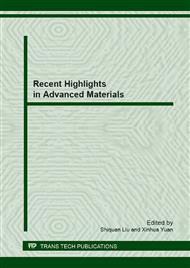[1]
Byrne R A,Sarafoff N,Kastrati A,et al,. Drug-eluting stents in percutane-ous coronary intervention: a benefit-risk assessment. Drug Saf, 2009, 32(9): 749-760.
DOI: 10.2165/11316500-000000000-00000
Google Scholar
[2]
Finn A V,Nakazawa G,Kolodgie FD,et al. Temporal course of neointimal formation after drug-eluting stent placement: is our understanding of rest-enosis changing. JACC Cardiovasc Interv, 2009, 2(4): 300-302.
DOI: 10.1016/j.jcin.2009.04.009
Google Scholar
[3]
Baoxin Ma, Ying Xu , Xianliang Liu, Suisheng Wu. The system evaluation of efficacy and safety in biodegradable drug-eluting stents . Chinese Journal of Gerontology, 2011, 31 (10) : 3883-3886.
Google Scholar
[4]
Hu Rong, Yali Wang. The properties, biocompatibility and complications implantated in coronary stent materials. Tissue engineering research and clinical rehabilitation, 2010, 14(16): 2999-3002.
Google Scholar
[5]
Fuqiang Huang, Zhentao Yu, Lijuan Luo, The study progress of titanium alloy intravascular stent. Titanium Industry Progress, 2007, 24(1): 29.
Google Scholar
[6]
Tepe G, Schmehl J, Wendel H P, et al. The biocompatibility of nitinol stents-in vitro evaluation of different surface modi-fications and coatings. Biomaterials, 2006, 27(4): 643.
DOI: 10.1016/j.biomaterials.2005.06.004
Google Scholar
[7]
Leng Y X, Chen J Y, Huang N, et al. The biocompatibility of the tantalum and tantalum oxide films synthesized by pulse metal vacuum arc source deposition. Nucl Instrum Methods Phys Res, 2006, 242: 30.
DOI: 10.1016/j.nimb.2005.08.002
Google Scholar
[8]
Zhangqi Liu, Chunliang Li. stent surface modification and intimal hyperplasia. Tissue engineering research and clinical rehabilitation, 2010, 14(25): 4721-4724.
Google Scholar
[9]
Xuchen Zhou, Dingyi Zeng, Qigang Guan, et al. Rapamycin and paclitaxel-eluting stents quantitative coronary angiography study of small pig early coronary artery inflammatory stenosis. Chinese Circulation Journal, 2006, 21(4): 262-265.
Google Scholar
[10]
Huiqiang Zhao, Wenyi Guo , Guoliang Jia, etc. The affect of Rapamycin and paclitaxel-eluting stents on blood inflammatory cytokines in patients with coronary heart disease after coronary intervention surgery [J]. Chinese Circulation Journal, 2005, 20(2): 98-100.
Google Scholar
[11]
Fanrong Diao , Anlin Lv , Junjie Li . The experimental study of rapamycin - tirofiban composite drug-eluting stents to prevent stent thrombosis and restenosis. Chinese Heart Journal, 2007, 19(4): 385-387.
Google Scholar
[12]
Yanchao Zhao, Xuebo Liu, Junbo Ge, et al. The study of Preparation and biocompatibility in Novel biodegradable cardiovascular eluting stents. Chinese Journal of Biomedical Engineering, 2008, 27(3): 438-442.
Google Scholar
[13]
Chunli Song, Jichang Zhang, Yang Xue Li, The intimal hyperplasia of canine coronary with estradiol biodegradable coated stent. Chinese Journal of Laboratory Diagnosis, 2011, 15(5): 772-775.
Google Scholar
[14]
Shu Ding, Genshan Ma. The clinical application progress of drug-eluting stents in the prevention of in-stent restenosis. Journal of Southeast University (Medical Science Edition), 2005, 24(2): 122-125.
Google Scholar
[15]
Yuyu Wu, Qingjun You, Xiaowei Qi . The experimental study of the biodegradable PDS stent in dogs. Shandong Medical Journal, 2009, 29(6): 40.
Google Scholar
[16]
Fully biodegradable stents the fourth revolution of coronary intervention. Practical Journal of Cardiac Cerebral Pneumal and Vascular, 2011, 19(6): 1027-1028.
Google Scholar
[17]
Erbel R. Progress AMS I Clinical Study. Late BreakingClinical Trials. Presented at ACC2006, Atlanta, G A.
Google Scholar
[18]
Chi Li, Yan Tang, Lili Tan, Preparation of and performance of biodegradable drug coating magnesium alloy surface. Chinese Journal of Materials Research, 2009, 23 (3): 300-303.
Google Scholar
[19]
Vogt F, Stein A, Rettemeier G, et al. Long-term assess-ment of a novel biodegradable paclitaxel-eluting coronary polylactide stent. Eur Heart J, 2004, 25(15): 1330-1334.
DOI: 10.1016/j.ehj.2004.06.010
Google Scholar


